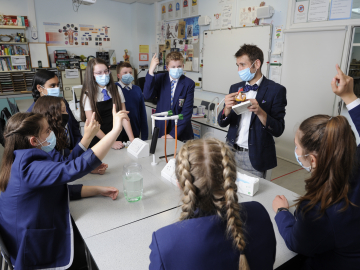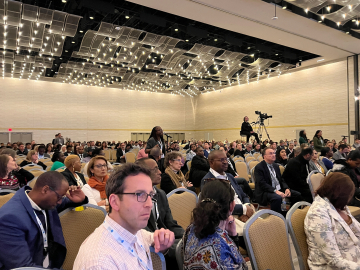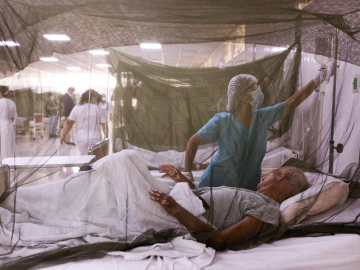GHN's Best Exclusives of 2017
It's been quite a year for global health, and GHN worked hard to bring you exclusive stories to help make sense of it all. Here is a sampling of some of our top exclusive reports, commentaries, and Q&As from 2017.
See also our Best Global Health Stories of 2017: Editors' Choices.
Blazing Injustice: Nepal's Hidden Crisis of Burn Injuries
Untold Global Health Story of 2017 - Images of Blazing Injustice: Nepal's Burn Survivors
Burns cause an estimated 180,000 deaths each year, yet they rarely rate a significant spot on the global health agenda.
In Nepal, an estimated 56,000 people are burned seriously each year—yet only about 1,000 receive proper treatment. Even then, the average time lapse between injury and reconstructive surgery is an unfathomable 18 years.
In a 3-part exclusive series for Global Health NOW, Joanne Silberner reports on the devastating effects of burns in the country—the Untold Global Health Story of 2017, submitted by Emaline Laney, a scholar from the London School of Hygiene and Tropical Medicine.
Joanne Silberner, October 2017 (Special Series)
False Distinctions Between International Health and Global Health
As the term “global health” gained steam, so did efforts to distinguish it from “international health.”
In the process, enthusiasts of the term “global health” sought to spin characteristics like a focus on health equity and multidisciplinary approaches as their new and exclusive purview. Yet the international health field has long espoused those fundamental attributes, writes David Peters, who chairs the Johns Hopkins Bloomberg School of Public Health Department of International Health, in a commentary clearing up some of the misconceptions.
For example, “International Health has never defined itself as bilateral aid between nations, although proponents of a distinct term for global health have tried to label it as such,” he writes.
November 2, 2017, David Peters (Commentary)
Powering Up to Fight Tobacco
In this exclusive commentary for GHN, former US CDC Director Thomas R. Frieden argues that, “Of the many steps governments can take to prevent people from getting sick, none can save more lives than reducing tobacco use.”
Tobacco could kill 1 billion people this century, and low- and middle-income countries are most threatened, Frieden says.
Nearly 200 million lives could be saved if top developing countries embraced anti-tobacco policies. Over the past decade, WHO Global Ambassador for Noncommunicable Diseases Mike Bloomberg and Bloomberg Philanthropies have invested nearly $1 billion in MPOWER policies to protect people from secondhand smoke, enforce tobacco ad bans and raise tobacco taxes.
“These policies cost little or no money to implement,” he writes.
Thomas R. Frieden for Global Health NOW (Commentary)
How to Fix the Broken Humanitarian System: A Q&A with Paul Spiegel
The Lancet’s multi-part series on humanitarian response couldn’t be more timely as the world struggles with multiple crises that have displaced tens of millions of people—a scale unseen since World War II.
Unfortunately, the humanitarian response system designed to help them is broken, says Paul Spiegel, author of an article in the series.
Reconfiguring humanitarian response to make it more coordinated and effective in dealing with prolonged crises like that of Syria is essential for the future, says Spiegel, director of the Hopkins Center for Humanitarian Health at the Johns Hopkins Bloomberg School of Public Health.
What’s needed? Stronger command and control of response, integration of displaced people into local economies and national health systems and fewer organizations involved in response, says Spiegel in a GHN Q&A.
Brian W. Simpson, June 9, 2017 (Q&A)
What's the Difference? A Primer on Evolving Health Disciplines
If you’ve pondered the proliferation of the various “healths” (public health, global health, planetary health, one health), GHN’s primer series aimed to assist.
Marija Cemma, PhD, explains the disciplines based on research and interviews with global experts—starting off with public health—from microbiologist Charles-Edward Amory Winslow’s classic 1920 definition, to public health in action examples from Alfred Sommer, Dean Emeritus of the Johns Hopkins Bloomberg School of Public Health.
Marija Cemma, September 27, 2017 (Special Series)
It’s Time to Take the Air Out of Pneumonia
“Breathing shouldn’t be a privilege. But it is”—because of pneumonia, which takes a child’s life every 2 minutes, wrote Keith Klugman, MD, PhD, in a commentary to mark World Pneumonia Day November 12.
Pneumonia kills 920,000 children each year—more than malaria and diarrhea combined. And 25 years ago, those deaths seemed unavoidable. Now, with the pneumococcal conjugate vaccine (PCV), it’s not only curable—it’s preventable, explains Klugman, Director of Pneumonia at the Bill & Melinda Gates Foundation. But still, the vaccine isn’t reaching about half of the world’s children, despite efforts that dropped the price to $9 per child. Klugman calls for a united effort to bring the cost south of $5, and to ensure the availability of oxygen therapy and antibiotics.
Keith Klugman, November 13, 2017 (Commentary)
Fresh Perspective: Tedros Adhanom Ghebreyesus
Tedros Adhanom Ghebreyesus is now installed as the WHO Director-General Race, taking over after Margaret Chan stepped down. But back when he was still in the running, Tedros made his case for being DG in a 4-part exclusive Q&A with GHN.
Ethiopia’s former Minister of Health and Minister of Foreign Affairs discussed his background, the greatest global health threats, the changes that he would bring to WHO (noting that universal health coverage would be his top priority), the idea that the next DG should be from a low- or middle-income country, and his country’s record on human rights.
Highlights:
“As Minister of Health for 8 years, I oversaw a reform effort that transformed Ethiopia’s health system, positively improving the lives of millions by bringing health care closer to communities…”
“As board chair of the Global Fund, I too led a reform effort, starting from a point in which donor confidence was low and culminating in raising $12 billion in 2013.”
Brian W. Simpson, May 9, 2017 (Q&A)
The Other Children in Brazil’s Zika Epidemic
The Zika epidemic in Brazil transformed the entire family unit, but Poonam Daryani noticed little attention being paid to the other children affected—the siblings of children with congenital Zika syndrome.
For obvious and rightful reasons, most of the resources and attention galvanized by the Zika outbreak in Brazil have focused on the thousands of children born with microcephaly and congenital Zika syndrome (CZS), Daryani—whose reporting was supported by a Johns Hopkins-Pulitzer Center Global Health Reporting Fellowship—explains. But the birth of a child with a condition as complex and demanding as CZS changes the entire family ecosystem. For many impacted families, the child with CZS was not their first—nor their last—born. Her photo series centers on the other children: the siblings who also feel and carry the weight of the Zika epidemic.
See also Poonam Daryani's GHN exclusive article, Beyond Mosquitoes: Sexual and Reproductive Health in the Wake of Zika, and her video slideshow, A Month with Mylene.
Poonam Daryani, October 6, 2017 (Special Report)
Reducing Gun Violence in the US (Video) – Daniel Webster and Brian W. Simpson, video discussion
Guns claim more than 33,000 lives in the US every year. What can be done to reduce these deaths? A lot, says Daniel Webster, director of the Johns Hopkins Center for Gun Policy and Research, in a video interview with Global Health NOW.
Evidence demonstrates that commonsense laws and community efforts such as outreach to people at highest risk for being a perpetrator or victim—as well as other strategies—could turn the tide of gun deaths, he says.
Surveys consistently show that gun owners and Republicans support gun safety policies, says Webster.
“The hopeful path forward is advancing this discussion beyond a cultural battle … to a very practical discussion,” he says. “There are things [that] gun owners agree we can and should do so that we have fewer gun deaths.”
Brian W. Simpson, November 16, 2017 (Video Q&A)
Medicine in India: The Dark Underbelly
A man in India thought he had had an appendectomy—only to discover much later that he’d been duped by corrupt surgeons who took his money, put him under and gave him fake stitches. Shocked by such stories, student Jinali Mody explained how unnecessary procedures and sham surgeries have become commonplace in some areas.
Mody details potential solutions, beginning with reform of the corrupt medical college admissions process and enforcement of anti-corruption laws—but warns that mindsets must change first.
Jinali Mody, June 23, 2017 (Commentary)
Plague’s Blast from the Past Carries a Major Lesson: One Health Matters
Epidemics and pandemics can rewrite history. The Great Plague of the medieval ages killed 75-200 million and wiped away 60% of the European population. In the 19th century, it killed 10 million in the Indian sub-continent alone.
Scientific advances have achieved significant progress in fighting diseases such as plague. We no longer believe in the obsolete theory of miasma (that plague is caused by bad air), and we understand better the pathogen (Yersinia pestis bacteria), the vector (fleas), and the reservoir (small rodents) that play a central role in the plague transmission cycle. We have rapid diagnostic tests to screen for the disease and multiple antibiotics to treat it. Plague should have been a scourge of a bygone era. Yet, Madagascar has been battling a plague outbreak, with cases that rapidly doubled from 500 in mid-October to over 1,554 cases and a death toll of 113 as of October 27, according to WHO-Africa.
Plague is also a prime example of a disease requiring a blended response, drawing on animal, human, and environmental health disciplines—in short, a One Health approach. Ahead of One Health Day, this commentary examined how the plague epidemic underscores the need for collective action from experts in these fields to prevent, detect, respond to, and recover from current and future infectious disease threats.
Sulzhan Bali, Catherine Machalaba, and Richard Seifman, November 1, 2017 (Commentary)
A woman laughs while working in a paddy field in Sakayal village of Dadeldhura District in Nepal. Image by Shehzad Noorani.




